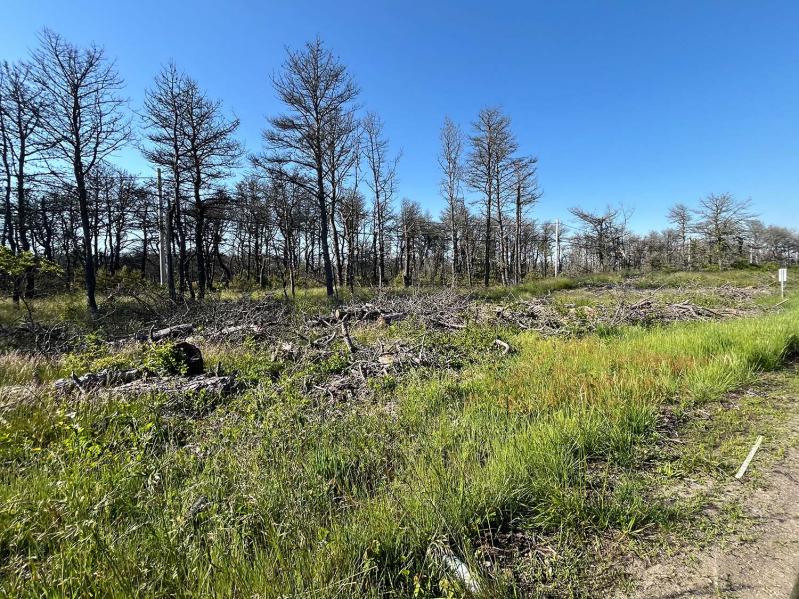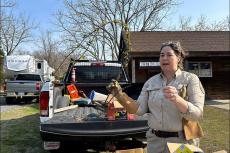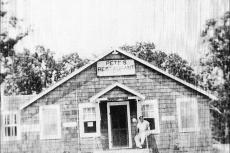The end-times landscaping job wrought by the southern pine beetle along Montauk Highway in Amagansett could seem pretty compared to how it would look after a fire.
“It’s a giant tinderbox out there,” said Chris Beckert, who is in his fourth year as chief of the Amagansett Fire Department.
“Maybe don’t even have recreational fires near those areas this time of year,” Dave Browne, the East Hampton Town’s chief fire marshal, suggested in a presentation about fire safety at a town board work session on Tuesday.

Along the Napeague stretch and within Napeague State Park thousands of trees have succumbed to the pine beetle. While a portion of the area is in the Montauk Fire District, most of it is in the Amagansett district, so if a fire started there, Chief Beckert and his department would get the call.
While the state spent some $1 million over the winter to create fuel breaks among the swaths of dead trees on Napeague and removed dead trees in areas adject to private residences, it has done a poor job communicating with the Amagansett Fire Department, Chief Beckert said.
At the May 21 East Hampton Town Board work session, Councilman David Lys said that the town had been speaking with the fire commissioners and Assemblyman Fred W. Thiele Jr. about the many dead trees, understanding that as people drive to the beaches this summer, it might be at the forefront of everyone’s minds. Councilman Tom Flight, who volunteers as an emergency medical technician for the Montauk Fire Department, has been pressing the state about access issues for the firemen.
“The goal of the May meeting was to work out a plan to get more funding to address the issues,” said Mr. Flight. There are many complicating factors, not the least being the crossing of jurisdictions. The stands of dead trees are on New York State Parks and the Metropolitan Transportation Authority property, with only minimal town land involved, but the southern pine beetle didn’t attack only the East End. “I’ve reached out to Chris and Gerry [Turza] and asked what they’ve heard from the state. They said very little. My goal is to make sure we have the resources for them to effectively manage the fire.” Councilman Flight is the town board’s liaison to the fire commissioners.
“They’ve had multiple meetings, but they never had a meeting with us,” said Mr. Beckert. “The dead trees, the concern is if you hit them with a truck, they just fall over. The top pops off and they hit the truck. The fire roads they put in where they thought was good, but they never consulted us.”
Last week, Councilmen Lys and Flight met with fire chiefs from across the town as well as Mr. Turza, Bruce Bates, the town’s emergency preparedness coordinator, and a regional representative for the New York State Parks, to help facilitate that communication. “The increased fire load, as a result of the southern pine beetle, is an ongoing challenge in which we will continue to partner with all municipal organizations to manage safely,” said Mr. Flight.
Afterward, Mr. Beckert said he pressed for more fire roads to ease access but that, “We really just exchanged contact information with the state and town, but nothing came from it. The state, I guess, has no more money to do anything. We discussed it would be a priority to make fire roads to be able to access the fire instead of the fire breaks, but without money there isn’t much to be done.”
“I just think it’s amazing that when the initial work was done no one spoke to us — the department or the district — and that’s principally our area,” said Jack Emptage, a volunteer firefighter and chairman of the board of the Amagansett Fire Commissioners. He’s been a firefighter on the East End for 35 years, and before that volunteered in New Jersey for 15 years. “We’re the ones who are going to have to deal with the issue. It would seem to me somebody would want to have our input, but evidently not.”
Dan Keefe, a public information officer with the New York State Office of Parks, Recreation, and Historic Preservation, said, “We’re surprised to hear that. Park management met with the fire department prior to phase one, and we incorporated their suggestions into the plan. Park management will be reaching out as we go forward.”
“The state never talked to us about the phase one plan,” countered Mr. Beckert.
Mr. Keefe said next steps included removing 10 acres of shrubby understory along the Bayview Avenue fuel break, which would start in late summer, after northern long-eared bat pups mature. In December, the Parks Department will remove dead trees along walking trails and will also start to process the downed woody material, beginning at the Promised Land Trail.
“We had some meetings last summer and fall with the New York State Department of Transportation and the Parks and Recreation Department,” Assemblyman Thiele said in a phone call. “Most of the work has been done by the D.O.T. and Parks. We’ve devoted additional resources to fire breaks, and we’re trying to address some of the issues with regards to fire safety by getting rid of the dead wood or chipping it. They made some progress, but all acknowledged that more work needed to be done. It’s a potential fire hazard. My basement is a testament to the wet spring, but they need to address it before it becomes a real problem.”
“Either the state or the county has gone in and just cut down dead trees and in most cases just left them there. That doesn’t solve a lot,” said Mr. Emptage. He remembers well the Westhampton Beach fires. “It was a tough duty, believe me.” He described nearly being trapped by the fire as the fire trucks sucked water out of a pool. “The closer it got the more nervous I got, but for whatever reason, the wind changed. Fires in these situations have a will and mind of their own. It literally took a left-hand turn and we never got touched. It was incredible. I went and lit a few candles after that one.”
“To leave it all there, not only does the fire risk remain, it also just looks terrible. My lord, if I was part of the village of Montauk and had a retail business there, I would be jumping up and down. They have cut some fire lanes near some of the houses, so that at least gives us some access, but beyond those lanes, with all the downed trees, we can’t go anywhere. All we would do is go in and get hung up with our brush trucks.”
However, it’s not as simple as just removing the trees. Councilman Flight said that D.E.C. regulations prevent their removal because of the beetle infestation. “State fire rangers told us that felled trees are part of the natural cycle,” said Mr. Turza, East Hampton Village’s fire and emergency medical services administrator. “Looking at it from the firefighter’s standpoint, we had a vertical fuel package. Now it’s on the ground, dead and decomposing. It should be holding more moisture, but now we run into an access problem. We have piles of lumber.”
Mr. Browne offered many common-sense tips about residential fire pits at Tuesday’s work session. Among them: Use a spark guard; don’t make a fire, even in a fire pit, on a day when wind gusts top 20 miles per hour; don’t burn brush or leaves; never leave a burning fire, and always have your garden hose nearby.
Nonetheless, the cannonball train heading east throws sparks if it hits the brakes too hard, and Amagansett firefighters are worried. “One of these days there’s going to be a good-sized fire out there and it’s going to put a strain on the volunteers,” said Mr. Beckert.
“A lot will be determined on whether we have a really dry summer,” said Mr. Emptage.




